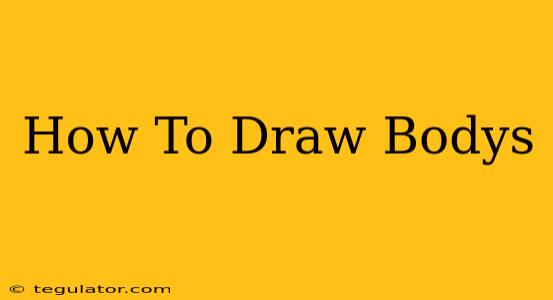Learning to draw the human body can seem daunting, but with practice and the right techniques, it becomes much more manageable. This guide breaks down the process into simple steps, perfect for beginners. We'll focus on understanding proportions, basic shapes, and adding detail to create realistic and dynamic figures.
Understanding Body Proportions
Before diving into details, grasping basic human proportions is crucial. While variations exist, a common guideline is to use the head as a unit of measurement. An average adult figure is approximately seven to eight heads tall.
Key Proportions to Remember:
- Head: The base unit of measurement.
- Shoulders: Roughly twice the width of the head.
- Waist: Located roughly halfway down the body.
- Hips: Slightly wider than the shoulders in women, similar or slightly narrower in men.
- Legs: Roughly equal in length to the upper body (from head to waist).
Breaking Down the Body into Basic Shapes
Instead of focusing on intricate details initially, simplify the body into basic geometric shapes. This approach makes it easier to understand the underlying structure and proportions before adding complexity.
Using Simple Shapes:
- Head: Oval or circle.
- Torso: Cylinder or slightly elongated oval.
- Limbs: Cylinders for arms and legs. Use slightly tapered cylinders to represent the natural narrowing of limbs.
Step-by-Step Drawing Process:
-
Sketch a Simple Wireframe: Begin by lightly sketching a basic framework using lines and circles to represent the head, torso, and limbs. This framework will guide your drawing and ensure accurate proportions. Focus on the overall posture and pose.
-
Refine the Basic Shapes: Once the wireframe is satisfactory, add the basic shapes (circles, cylinders, ovals) over the lines to create the volume and form of the body.
-
Add Muscular Detail (Optional): For more advanced drawings, gradually add muscle mass, defining the major muscle groups. Remember that muscles are not just lumps; they have flow and shape according to movement and body type.
-
Add Details: Once the basic structure is complete, start adding smaller details like hands, feet, facial features, and clothing.
-
Refine and Shade: Refine the lines and add shading to give your drawing depth and realism. Shading helps to define the form and create a three-dimensional effect.
Practice Makes Perfect
Drawing bodies effectively takes time and dedicated practice. Don’t be discouraged by initial challenges. Start with simple poses and gradually increase the complexity. Experiment with different angles and perspectives.
Resources for Further Learning:
- Online Tutorials: Numerous online platforms (YouTube, Skillshare, etc.) offer excellent video tutorials on figure drawing.
- Anatomy Books: Studying human anatomy provides invaluable insight into the structure of the body and improves your ability to draw realistic figures.
- Life Drawing: Participate in life drawing sessions to improve your observation skills and understanding of human forms.
Keywords:
How to draw bodies, draw body, human body drawing, figure drawing, drawing tutorial, body proportions, basic shapes, step by step drawing, drawing for beginners, improve drawing skills, human anatomy for artists, life drawing techniques, realistic drawing, drawing muscles, shading techniques.
By following these steps and consistently practicing, you’ll improve your ability to draw bodies accurately and expressively. Remember, the key is patience and persistence. Happy drawing!

